 |
 |
 |
Sigmar Polke: Alice in Wonderland
Matthew Larking |
 |
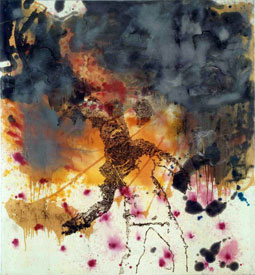 |
 |
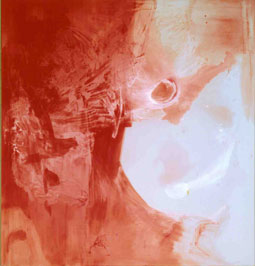 |
Sigmar Polke
The Dreams of Menelaus
(Cow and Sheep go together but the Eagle climbs alone)
Dispersion, aluminum, manganese, and ferrous mica on canvas, 260 x 240 cm, 1982
Courtesy of The National Museum of Art, Osaka |
 |
Sigmar Polke
Cinnabar I
Chemically clean cinnabar on canvas, 200 x 190 cm, 2005
Courtesy of The National Museum of Art, Osaka |
 |
Gerhard Richter, Sigmar Polke's early collaborator and contemporary from the Kunstakademie in Dusseldorf, set the tone in 1964: ''Pictures which are interpretable, and which contain a meaning, are bad pictures.'' Polke was one of the first artists to combine often incommensurable styles and subject matters. His melding of, and flights between, approaches as different as low art, Pop, expressionism, symbolism and high-modern abstraction cultivated unintelligibility in his works. It also seemed to make them more perceptually and intellectually alluring even while they paraded as the sometimes empty gestures of stylistic cliche.
The Polke exhibition ''Alice in Wonderland'' is currently on the final leg of its Japan showing, now in Osaka at the National Museum of Art till June 11, and previously in Tokyo at the Ueno Royal Museum. The project had been in discussion since Polke's visit to Tokyo to receive the prestigious Praemium Imperiale in 2002, and owing to the majority of works coming from Polke's own collection, it has also been termed an exhibition of ''Polke by Polke.'' Given that, it might seemingly be infused with a sense of autobiography. But as it turns out, the body of work is as unrevealing in its meanings as Polke is notoriously circumspect about his private life.
An excellent example of this is the title piece of the exhibition, ''Alice in Wonderland'' (1971). The left and right are flanked with fabric prints showing the energetic movements of soccer players, over the top of which on the right side is painted a ghost-like volleyball player reaching for a ball. The fabric is of course stretched over the painting frame, resonating with the stretching sportsmen's movements. Through the middle and lower sections are sketched Sir John Tenniel's image of Alice along with the caterpillar smoking a hookah atop a mushroom. As Alice eats from either side of the mushroom, she is going to grow or shrink, depending on which side she eats from.
|
 |
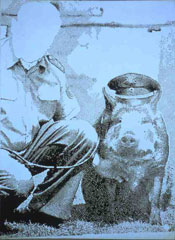 |
Sigmar Polke
Police Pig
Dispersion on canvas, 300 x 225 cm, 1986
Courtesy of The National Museum of Art, Osaka |
 |
The references are muscularly and cerebrally elastic, but also incomplete as sources for explanation. Other avenues for interpretation would have to reckon with the ''Polke-dots'' that fill the middle and lower canvas and which hark back to the artist's early grid pictures, of which ''Police Pig'' (1986) is the closest example in the exhibition; the low art of the commercial fabrics; the incorporation of book illustration (a step above commercial design); and the seemingly biographical instance of the magic mushroom -- perhaps alluding to Polke's LSD experimentation. The fabric use owes something to Picasso and Braque's synthetic cubist phase from 1912, as does the collage-gist of the piece in its borrowings from diverse provenances.
Veiling artworks in obscure meanings has been a strategy in painting from at least the mid-60s with the advent of postmodernism's whimsical disenchanting of the high-seriousness of modernism through parody and irony. An example from the show could be the four recent works given a spicy overtone by their title, ''Cinnabar'' (2005). They adopt the look of abstract expressionism, although the ''expressive'' force is curiously curtailed. The surface begins to look scraped and worn as if the brush had been searching something out while long since having given up the last of its pigment.
Cinnabar is the red sulphide of mercury, a principal substance of alchemy, and so it will come as no surprise that Polke alleges an affinity with the obfuscating cousin of modern chemistry. A centrally important metaphor for painting and alchemy has been ''transformation'' -- pigment to picture, lead to gold. Polke's own cult of celebrity proves instructive of such metamorphoses. Martin Kippenberger spoke to the point about the artist's early years: ''everyone knew he was the man of the seventies, yet there was still a terrific amount of hesitation, and it was ages before they (museums) finally bought any of it.'' Polke went on to become a sacred cow of American galleries in the 80s and 90s. Now, it seems, he gets to curate his own exhibitions. That kind of transformation would be one to impress even his medieval forbears.
|
 |
 |
 |
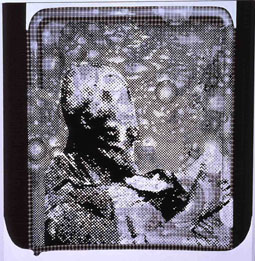 |
Sigmar Polke
Alice in Wonderland
Mixed media on patterned fabric, 300 x 290 cm, 1971
Courtesy of The National Museum of Art, Osaka |
 |
Sigmar Polke
Alien
Mixed media on fabric, 200 x 190 cm, 2003
Courtesy of The National Museum of Art, Osaka |
 |
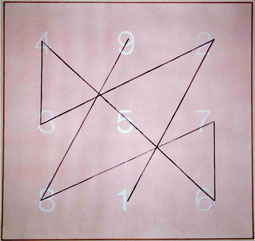 |
 |
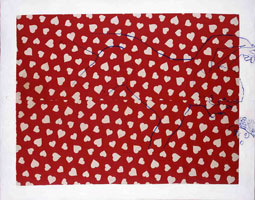 |
Sigmar Polke
Magic Squares I (Saturn)
Iridescent interference paint and iron oxide on canvas, 190 x 200 cm, 1992
Courtesy of The National Museum of Art, Osaka |
 |
Sigmar Polke
The Lovers
Acrylic paint and print fabric, 190.5 x 150.5 cm, 1972
Courtesy of The National Museum of Art, Osaka |
 |
|